Gimbap (Kimbap): the Recipe for the Korean Seaweed Rice Rolls

Gimbap, also called kimbap, is a Korean rice roll, wrapped in seaweed and stuffed with different ingredients that can change according to your personal tastes. The name comes from the Korean terms gim and bap, meaning dried seaweed and boiled rice, respectively. In South Korea they are usually enjoyed as a snack: convenient to carry in the special bento boxes (our local lunch boxes) for a quick lunch, they are also offered as a tasty snack.
In our recipe we prepare them in two versions: the first is filled with a mixture of canned tuna and mayonnaise, carrot sticks, radishes and cucumbers; the second, however, includes an omelette and shredded cheddar. The process is very simple, because once the sushi rice or gohan rice has been cooked, you just need to spread it on a sheet of gim seaweed, the classic Korean one, or nori, more easily available in grocery stores, place the fillings and roll the seaweeds up tightly.
After resting for half an hour in the refrigerator, the gimbap will be ready to be cut into rounds, grabbed with chopsticks and savored in one bite. You can change the filling as you like, opting, for example, for kimchi, the traditional fermented and spicy cabbage, crab surimi, cooked prawns, pickled daikon and everything else that instinct and imagination suggest.
You won't need any additional condiments because, unlike sushi, gimbap is already very tasty; if you like it, however, you can serve it with a small bowl of soy sauce, perhaps during an aperitif with friends or to enrich an oriental-inspired finger food buffet: you will win over your guests.
Find out how to prepare gimbap by following the step-by-step procedure and tips.
Ingredients
How to Prepare Gimbap
;Resize,width=712;)
Pour the rice into a bowl, add the water and wash it well, mixing with your hands; the water will become white, because it'll be rich in starch released by the rice: drain it and repeat the operation several times. Transfer the rice into a saucepan and pour the 400-450 millimeters of water necessary for cooking.
Pour the rice into a bowl, add the water and wash it well, mixing with your hands; the water will become white, because it'll be rich in starch released by the rice: drain it and repeat the operation several times. Transfer the rice into a saucepan and pour the 400-450 millimeters of water necessary for cooking.
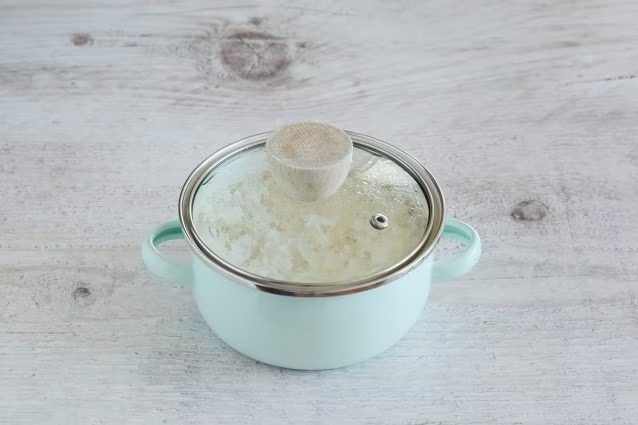;Resize,width=712;)
Close the lid and bring to a boil, then lower the heat to minimum and continue cooking for another 12-15 minutes, until the water has been completely absorbed by the rice. Remove the pan from the heat and let it rest for 5 minutes, without removing the lid.
Close the lid and bring to a boil, then lower the heat to minimum and continue cooking for another 12-15 minutes, until the water has been completely absorbed by the rice. Remove the pan from the heat and let it rest for 5 minutes, without removing the lid.
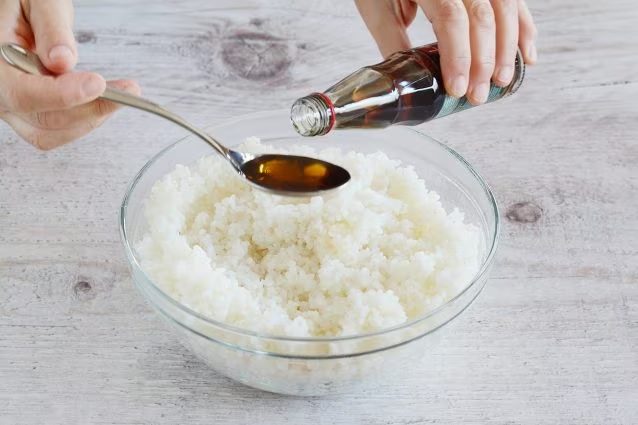;Resize,width=712;)
Transfer the rice to a large bowl and toss with the sesame oil and salt. Cover the bowl with a towel and let it cool to room temperature.
Transfer the rice to a large bowl and toss with the sesame oil and salt. Cover the bowl with a towel and let it cool to room temperature.
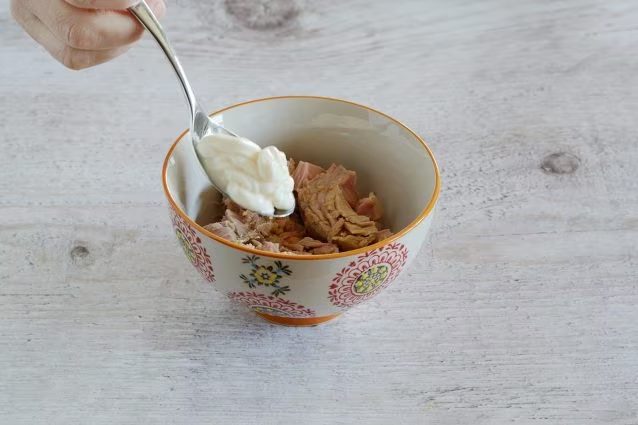;Resize,width=712;)
Drain the canned tuna, pour it into a bowl and season it with mayonnaise and a pinch of pepper.
Drain the canned tuna, pour it into a bowl and season it with mayonnaise and a pinch of pepper.
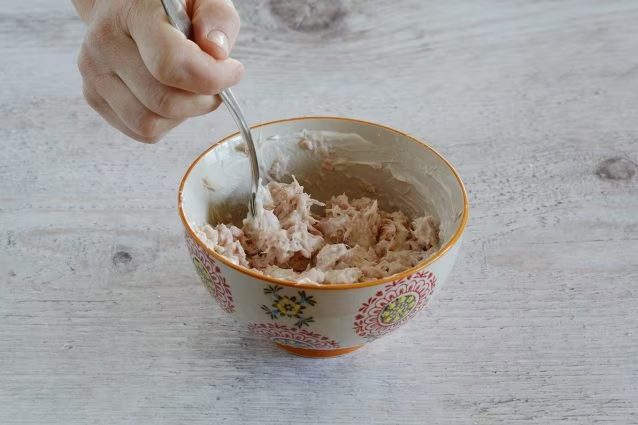;Resize,width=712;)
Mix well, so as to combine the ingredients.
Mix well, so as to combine the ingredients.
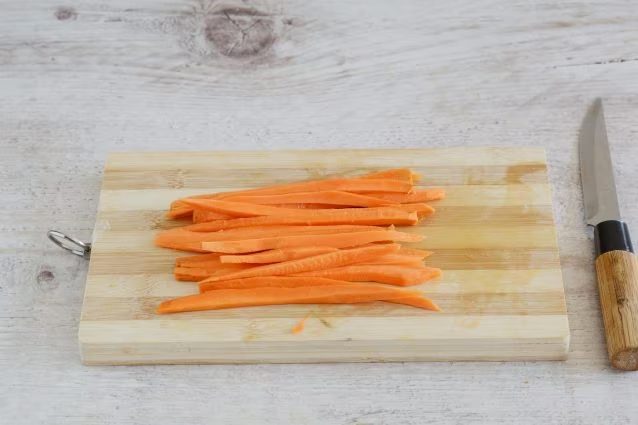;Resize,width=712;)
Cut the carrots into sticks of about 1/2 centimeters thickness.
Cut the carrots into sticks of about 1/2 centimeters thickness.
;Resize,width=712;)
Sauté the carrots in the pan with a drizzle of oil and a pinch of salt for 2-3 minutes, until they are slightly softened but still crunchy; let them cool completely.
Sauté the carrots in the pan with a drizzle of oil and a pinch of salt for 2-3 minutes, until they are slightly softened but still crunchy; let them cool completely.
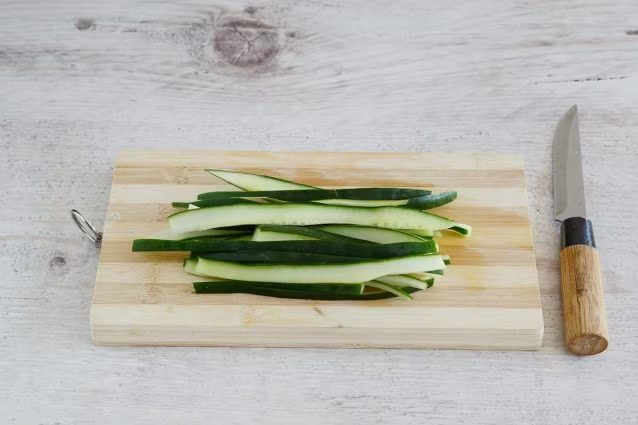;Resize,width=712;)
Remove the seeds from the cucumber and cut it into not too thin sticks.
Remove the seeds from the cucumber and cut it into not too thin sticks.
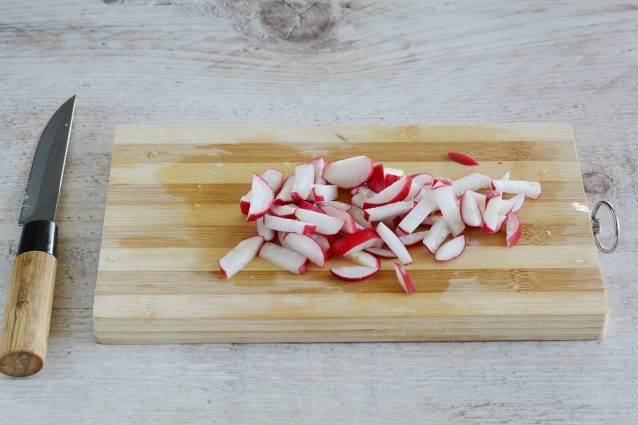;Resize,width=712;)
Also slice the radish, obtaining sticks.
Also slice the radish, obtaining sticks.
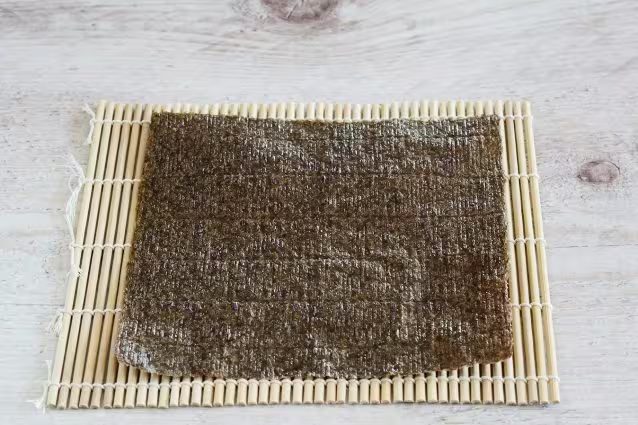;Resize,width=712;)
Place a seaweed sheet on the bamboo mat. If you prefer, you can first cover it with a sheet of cling film, which will make the operation easy and leave things clean.
Place a seaweed sheet on the bamboo mat. If you prefer, you can first cover it with a sheet of cling film, which will make the operation easy and leave things clean.
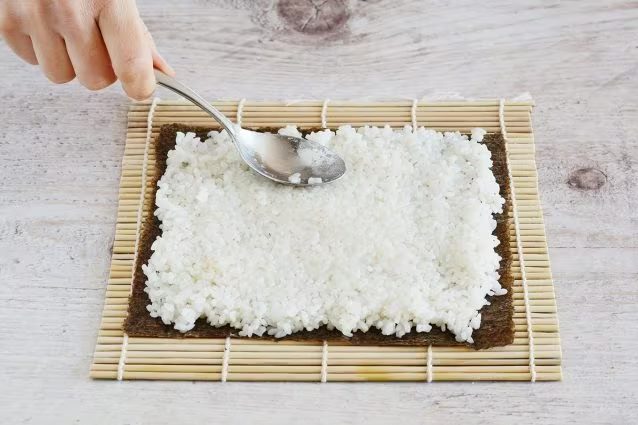;Resize,width=712;)
Distribute a thin and uniform layer of rice, using the back of a spoon moistened with a drop of water, leaving the edges of the seaweed free.
Distribute a thin and uniform layer of rice, using the back of a spoon moistened with a drop of water, leaving the edges of the seaweed free.
;Resize,width=712;)
Stuff with two tablespoons of tuna and mayonnaise.
Stuff with two tablespoons of tuna and mayonnaise.
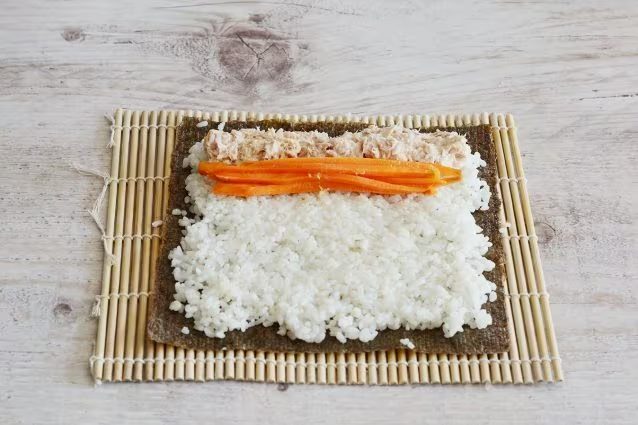;Resize,width=712;)
Add a small pile of carrots, well aligned.
Add a small pile of carrots, well aligned.
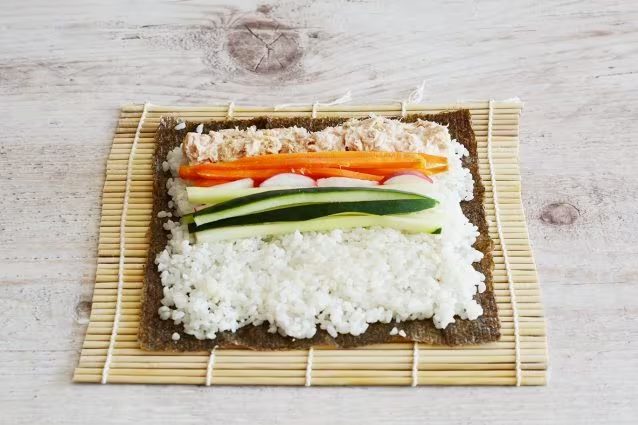;Resize,width=712;)
Arrange a row of radishes and a few cucumber sticks.
Arrange a row of radishes and a few cucumber sticks.
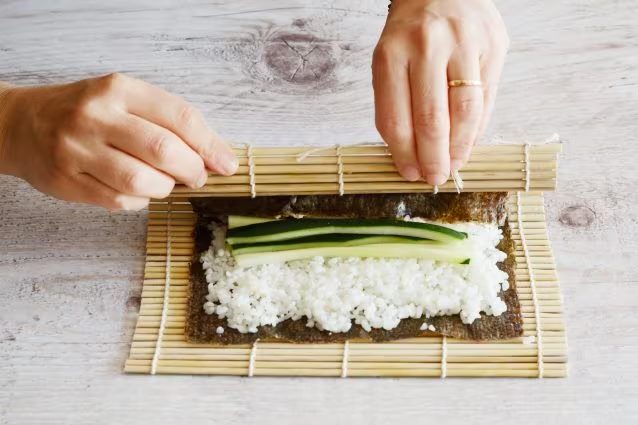;Resize,width=712;)
Roll up the roll, squeezing the bamboo mat tightly with each turn. Set the first gimbap aside.
Roll up the roll, squeezing the bamboo mat tightly with each turn. Set the first gimbap aside.
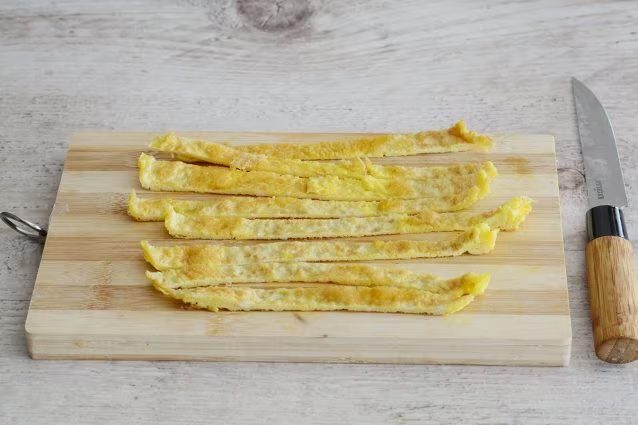;Resize,width=712;)
Take care of the second roll: make a thin omelette, using two eggs, then place it on a cutting board and cut it into strips.
Take care of the second roll: make a thin omelette, using two eggs, then place it on a cutting board and cut it into strips.
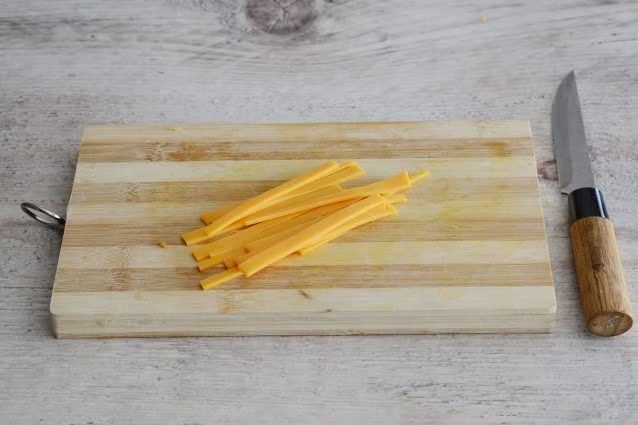;Resize,width=712;)
Slice the cheddar cheese.
Slice the cheddar cheese.
;Resize,width=712;)
Make another roll, filling it with the omelette and cheese.
Make another roll, filling it with the omelette and cheese.
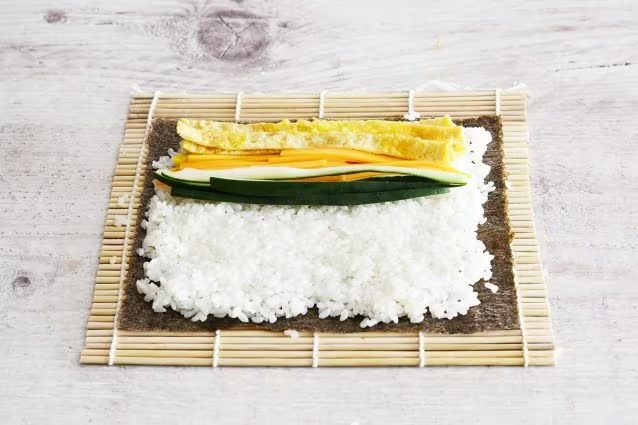;Resize,width=712;)
Also add a few cucumber sticks and, if you want, any other ingredients at your disposal.
Also add a few cucumber sticks and, if you want, any other ingredients at your disposal.
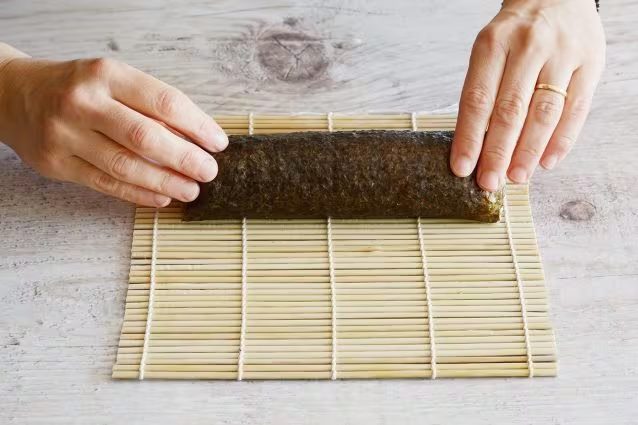;Resize,width=712;)
Roll up and tighten well, sealing it. Let both gimbaps rest in the refrigerator, wrapped in cling film, for at least 30 minutes.
Roll up and tighten well, sealing it. Let both gimbaps rest in the refrigerator, wrapped in cling film, for at least 30 minutes.
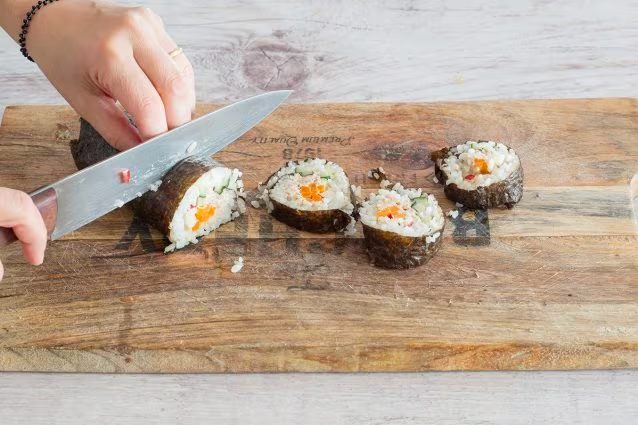;Resize,width=712;)
Once the necessary time has passed, cut the two rolls into slices about 1 centimeter thick, using a sharp knife, greased with a drop of sesame oil or wet with cold water. Arrange all the rolls on a serving plate.
Once the necessary time has passed, cut the two rolls into slices about 1 centimeter thick, using a sharp knife, greased with a drop of sesame oil or wet with cold water. Arrange all the rolls on a serving plate.
;Resize,width=712;)
Your gimbap, or kimbap, are ready to be enjoyed, accompanied by a small bowl of soy sauce.
Your gimbap, or kimbap, are ready to be enjoyed, accompanied by a small bowl of soy sauce.
Curiosities and Variations
There are several theories about the origins of gimbap. The first claims that a similar recipe, ancestor of the current one, was already widespread in the country in the nineteenth century, and gradually became a typical preparation. A second theory, however, states that the dish was born following the Japanese occupation of Korea, which took place between 1910 and 1945: it seems that it was norimaki, Japanese sushi without raw fish, that inspired the Koreans.
Gimbap can be prepared in many variations. In addition to the classic version, it is also possible to taste Chungmu gimbap, originating from the town of Chungmu, which consist of thin rolls filled only with rice, served with a salad of spicy squid and radish kimchi. A version similar to Japanese onigiri, however, is the Samgak gimbap, triangular in shape, filled with different ingredients. Nude gimbap are also famous, similar to uramaki, in which rice and seaweed are reversed; finally, particularly loved by Koreans, are Mayak gimbap, a specialty of the Gwangjang market in Seoul: the word mayak means "drug" and refers to the goodness and irresistible flavor of these morsels.
How to Store Gimbap
We recommend enjoying the gimbap at the moment. However, if you have any leftovers, you can store it in the refrigerator, tightly closed in an airtight container, for a maximum of 1 day.
;Resize,width=767;)
;Resize,width=712;)
;Resize,width=712;)

